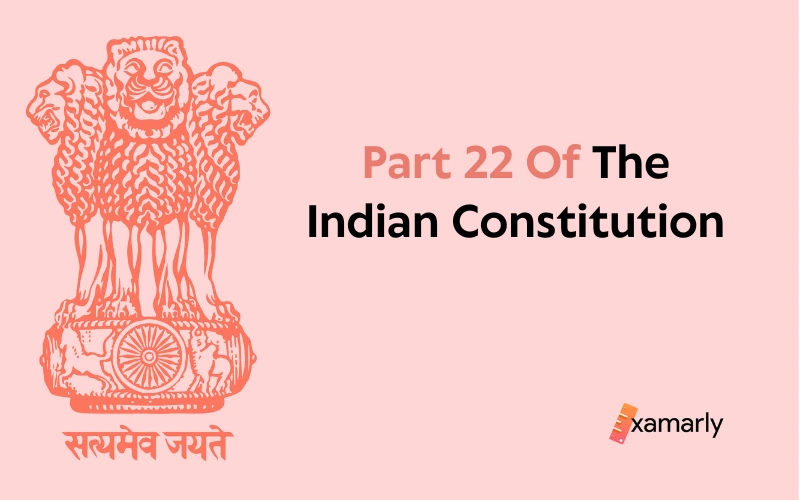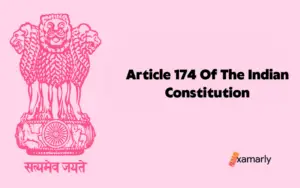The Indian Constitution is a guiding light for the nation, but it’s important to remember that it’s also a legal composition. Part 22 of the Indian Constitution lays out the nitty-gritty details of this Constitution, from the short title to the date of commencement, and the authoritative Hindi text, as well as any previous legislation that it repeals.
In this blog post, we’ll take a closer look at Part 22, and explore the importance of Part 22 in understanding the Constitution of India
All About Part 22 Of The Indian Constitution
The laws relating to the union of states that make up India’s country and its constitution are collected in Part XXII. Short title, commencement date, authoritative text in Hindi, and repeals are all covered under the articles in this section of the constitution. This Part contains Articles 393, 394, 394A, and 395.
Article 393: Short Title
The “short title” of the constitution refers to the name by which it is commonly known. The short title is included in Article 393 of the Indian Constitution of Part XXII to ensure that there is no confusion about the document being referred to. It says that This Constitution could also be referred to as the Constitution of India.
Importance Of Short Title
The “short title” of the Constitution is an important feature as it ensures that there is no confusion about the document being referred to. It serves as a shortened and commonly used name for the Constitution so that people are able to easily identify it.
The short title is included in Part XXII to ensure that there is no confusion about the document being referred to. Providing a short and simple name for the Constitution makes it more accessible for people to talk about, refer to and cite the Constitution. Additionally, when multiple laws are in effect and are being referred to, the short title helps to quickly identify which document is being referred to, avoiding any confusion. It is also helpful for legal citations, making it easier to reference the Constitution in legal documents.
Article 394: Commencement
Article 394 of the Indian Constitution states that certain provisions of the Constitution came into effect at an earlier date than the rest of the Constitution, which was officially adopted on January 26, 1950. This article serves as the commencement provision which allows for the smooth transition to the new Constitution and ensures that certain provisions are already in place before the rest of the Constitution becomes effective.
Note: Check out the linked article to figure out which Articles came into force before the commencement of the Constitution and which came along with the enactment of the Indian Constitution. Also, learn more about Article 394A from this linked Article.
Article 394A: Authoritative Text In The Hindi Language
“Authoritative text in Hindi” refers to the provision of having an official Hindi version of the constitution that is considered equally authentic as the English version. This is an important feature as Hindi is one of the official languages of India, and it ensures that the Constitution is accessible to all citizens, regardless of their preferred language.
Article 395: Repeals
Article 395 of the Indian Constitution contains a provision that revolves around “repeals.” “Repeals” refer to the previous laws that are no longer valid. This is an important provision as it ensures that the Constitution is the supreme law of the land and it supersedes any previously existing legislation.
Note: Check out the linked article to know which previous acts or laws have been repealed under this Article.
Which Amendment Has Amended Part XXII?
58th Amendment of the Constitution of India has amended Part XXII and inserted the word “Authoritative Text In Hindi” in its title.
With the inclusion of an “Authoritative Text in Hindi” in Part XXII, the Indian Constitution opens its doors to a wider audience. This provision ensures that the Hindi version of the Constitution is given the same legal standing as the English version, making it possible for more citizens to understand and connect with the Constitution in the language they are most comfortable in. This is particularly important as Hindi is one of the official languages of India, and this provision ensures that the Constitution is not only accessible but also inclusive and reflective of India’s diversity
Winding Up
In conclusion, the Indian Constitution is a document that guides our nation, but its true power lies in the nitty-gritty details. Part 22 lays out the foundation for the Constitution, including the short title, the date of commencement, the authoritative Hindi text, and the repeal of any previous legislation.
As we’ve seen, these details may seem small, but they play a critical role in shaping the political and legal geography of India. We hope this blog post has been an interesting and informative journey, and we encourage you to continue exploring the Constitution and its workings.
In the interest of additional readings:
FAQs On Part 22
What Are The Articles Included In Part 22 Of The Indian Constitution?
Part 22 contains Articles 393, 394, 394A, and 395 in the Indian Constitution. Article 393 explains the short title of the Constitution, Article 394 lays out the effective date of certain articles and the process for Constitution coming into operation, Article 394A deals with the authoritative text in Hindi while Article 395 lays out that certain acts will be repealed.
What Is The Significance Of The Phrase “Authoritative Text In Hindi” In Part 22?
The phrase “Authoritative Text in Hindi” was inserted into the title of Part 22 by the 58th Amendment to the Indian Constitution. It is significant because it ensures that the Hindi version of the Constitution is considered an authoritative text, meaning it has the same legal standing as the English version of the Constitution. This makes the Constitution more accessible to all citizens, regardless of their preferred language, as Hindi is one of the official languages of India.
What Is The Purpose Of Part XXII Of The Indian Constitution?
The main purpose of Part XXII is to lay out the details of the Constitution, including the short title, the date of commencement, and the repeal of any previous legislation. This section sets the foundation for the rest of the Constitution by specifying the mechanics of how it operates, such as when certain articles will come into effect, and what previous laws will be repealed in order to make way for the new Constitution. This helps to make a smooth transition from British India to the current Indian union. The addition of authoritative text in Hindi also extends the accessibility of the Constitution to more people, by allowing for greater understanding for those who are more comfortable reading and understanding the Constitution in Hindi, which is an official language of India.






